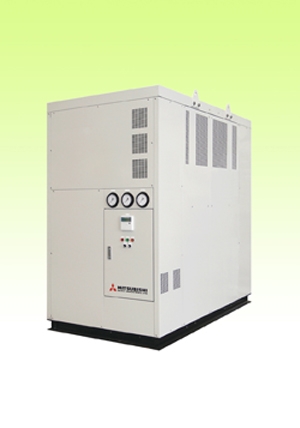Press Information
MHI Develops Heat Recovery Type Centrifugal Heat Pump
To Enable Continuous Supply of 80°C Water
-- Significant CO2 Reduction by Utilization of Waste Heat --
To Enable Continuous Supply of 80°C Water
-- Significant CO2 Reduction by Utilization of Waste Heat --
Tokyo, October 1, 2009 - Mitsubishi Heavy Industries, Ltd. (MHI) has developed and started marketing of an innovative hot water supply system, a heat recovery type water to water centrifugal heat pump which enables the continuous supply of 80 degrees Celsius (°C), or 176 degrees Fahrenheit (°F), hot water - suitable for production process in factories - by utilizing waste heat exhausted from the factories themselves. The "ETW," which is operated by electric power, does not require fossil fuels and is capable of reducing the emission of greenhouse effect gas (CO2) by more than 70%. At the same time, the system will enable considerable reduction in operational costs through its energy-saving features. MHI is currently exploring customer needs for the reduction of environmental burden in various industrial applications aggressively, including heating and sterilization of foods and cleansing of semiconductors.

The "ETW" utilizes the thermal-energy of the wasted hot water to raise the temperature of used hot water, which was lost in the various processes, and enables the reheating of 75°C used hot water to 80°C. Specifically, the system uses the wasted hot water, with temperatures ranging from 35°C to 50°C, as heat-source water from which thermal energy is derived and supplied for reheating through heat pump mechanism. The system uses HFC-134a as a refrigerant. The heat pump system has two heat exchangers (evaporator and condenser), a centrifugal compressor and a motor to evaporate, compress and condense HFC-134a. The system uses an inverter speed control to minimize electric power consumption. In the standard model, the system is able to raise the temperature by 5°C.
As the system utilizes wasted hot water, it provides high energy-saving efficiency with COP (coefficient of performance)*1 4.5*2. By partially replacing the boilers in use with MHI 's new system, a considerable reduction of CO2 emissions and energy-savings become possible. Compared with an oil-fired through-flow boiler with the same heating capacity (one ton of steam per hour), the new MHI system is able to reduce CO2 emissions by maximum 74% and operational costs by maximum 65%.
Recently, with a view to realizing environmentally-friendly factories that leave no waste products, the need to reduce fossil fuel consumption by utilizing waste heat is increasing. Electricity providers are actively proposing electrification of all household energy needs to their customers. They are also focusing on further development of effective tools which can be proposed as solutions for "factory-electrification" to the industry. Responding to these needs and initiatives, MHI has entered into the industrial-use heat pump product field, combining its existing heating, air-conditioning and refrigeration technologies, including centrifugal compressors, inverters and high-temperature compliant designs. In marketing this system, MHI will collaborate with electricity providers and aggressively explore customer needs, including boiler replacement needs and support industrial efforts to reduce the burden to environment.
Major Specifications of " ETW "
Hot water power output: 627 kilowatts (kW)
Power consumption: 139.3 kW
Motor output: 115 kW
Hot water flow rate: 107.8 cubic meters per hour (m3/h)
Heat source water flow rate: 84.9 m3/h
Power source: three-phase, 380 – 440 volt (V), either 50 or 60 hertz
Dimensions (height x depth x width): 2.1 meters (m) x 2.2 m x 1.2 m
Shipping weight: 3.2 tons
Operation weight: 3.7 tons
Notes:
1) Coefficient of performance (COP) indicates the ratio of a system’s useful energy output versus the system’s energy input. The higher a system’s COP, the higher its energy-saving efficiency. In the case of refrigeration systems, COP = rated cooling capacity (kW) / power consumption (kW).
2) In the case of heat-source water entering temperature is 45°C and reheated hot water leaving temperature is 80°C.
3) Refrigeration ton represents the refrigerating capacity for turning 2000 lb of 0℃ water into 0℃ ice in 24 hours. 1 RT = 3,024 Kcal/hr.
About MHI Group
Mitsubishi Heavy Industries (MHI) Group is one of the world’s leading industrial groups, spanning energy, smart infrastructure, industrial machinery, aerospace and defense. MHI Group combines cutting-edge technology with deep experience to deliver innovative, integrated solutions that help to realize a carbon neutral world, improve the quality of life and ensure a safer world. For more information, please visit www.mhi.com or follow our insights and stories on spectra.mhi.com.






